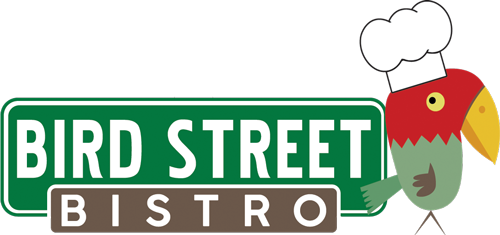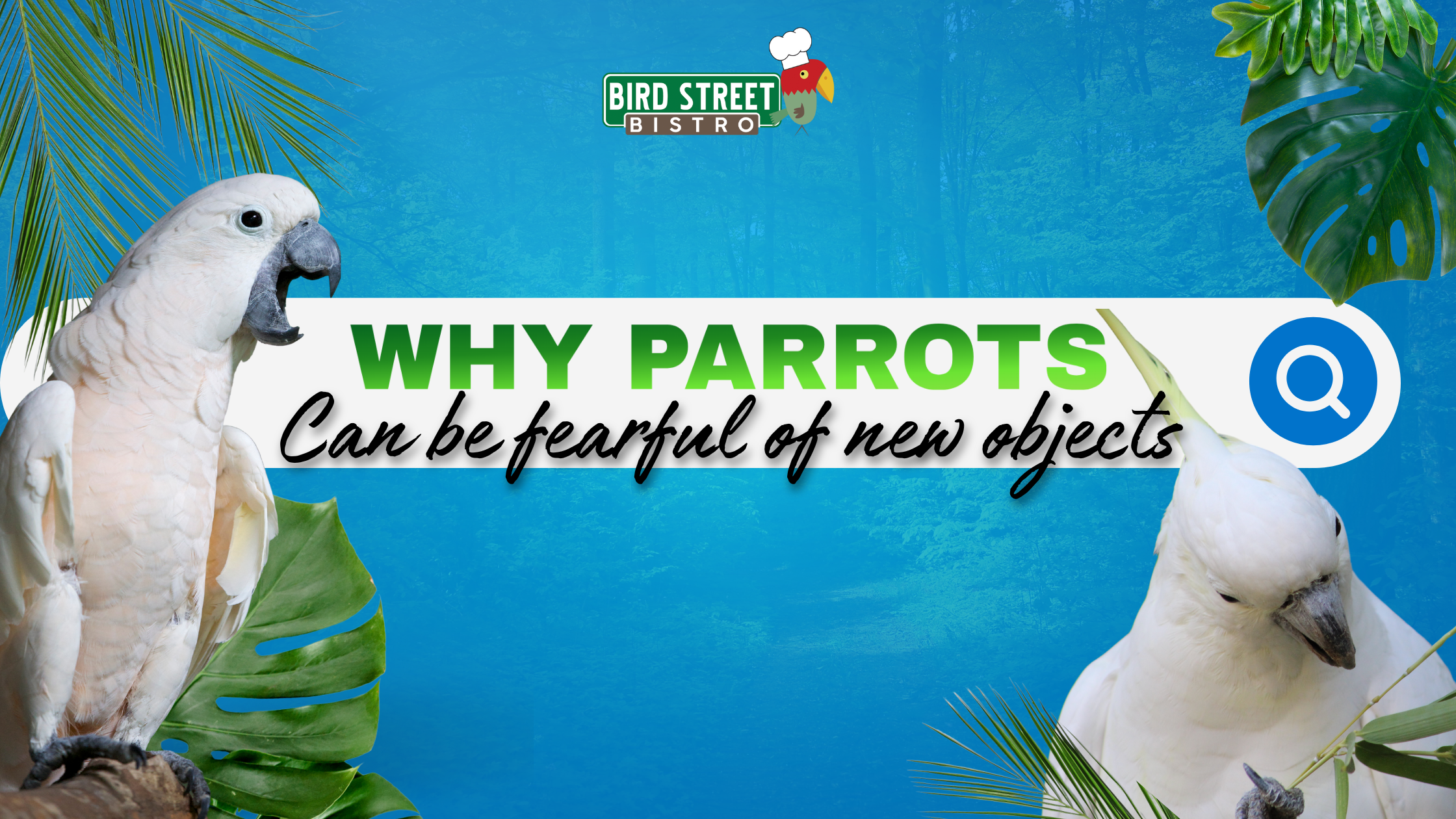Why Parrots Can Be Fearful of New Objects
Let's imagine a scenario. You are at the bird store and a toy catches your eye. “My bird would love this!” you think to yourself. It might be a little pricey or different than what she’s used to, but you decide to buy it because you want her to have fun and have something new to do. You get home, greet your bird, and pull the toy out of the bag - and she flies away in terror. You put the toy closer, but she continues to back away and display fear - she might even cry out. This is a common situation for parrot owners. Many people decide to give up on the new thing or some do even worse: they force the bird to be exposed to it against their will. Neophobia is described as a tendency to dislike anything new and a fear of novel things and situations. Let's learn more about it and how to handle a fearful bird without giving up on new objects or traumatizing them in the process.
Why Are Some Parrots Neophobic?

Most animals display a fear of new situations and objects. You’ve probably even noticed it with yourself when you’ve seen something that you don’t quite understand or just seems “off” and you feel uncomfortable or have the urge to get away. You’ve probably noticed this anytime you’ve come upon a rabbit or a squirrel and it runs away, or birds in a nearby tree scatter when a lawn mower is turned on. Or maybe you have a dog or cat that expresses fear around a certain object or situation like the vacuum cleaner. Their reasons may vary, but that fear response likely developed and evolved to help protect the animal from danger. Where a particular species of parrot is from can affect their behavior. Some species of parrot live in areas that might require them to be more open to novel situations.
Like with many animals, how a parrot experiences the world when it is young can also have a strong effect on how it will behave in the future. Less stimulus and opportunity to explore early on may result in a bird that is more wary of such things as it ages. Young birds seem to display more openness to exploring novel situations than older birds. Whether or not they are allowed to do so early in life and how often may be one contributing factor to how fearful they will be of new things as adult birds. Unfortunately, a cycle often emerges when a parrot shows fear of something and a person puts the toy or perch away or returns it to the store and that parrot never gets used to discovering and exploring new things.
Neophobia can’t be explained merely by looking at a bird’s personality, labeling it as a “fearful bird” or a “prey animal” and working from there. It helps to understand the individual bird and its experiences in its life as well as how its species lives in the wild.
How to Introduce New Objects to a Fearful Bird

Even if a bird displays fear in response to a new toy or other object, that doesn’t mean that there is no hope of them accepting it. The bird is only reacting because of its instinct and previous experiences or lack thereof. Something that causes fear when introduced can become one of their favorite toys or places to perch and play once the bird no longer sees it as a possible threat. By giving in and not providing new things for a fearful parrot to try, one might be doing more harm than good. This is because parrots need enrichment to be healthy. So, as long as what you are introducing to them is beneficial to their wellbeing or is necessary then there is no need to avoid doing so.
You can safely introduce new things and encourage them to explore them if you’re willing to give them some time and observe their behavior. Parrots tell us a lot with body language and vocalizations if we listen and observe. Learning to truly observe our parrot isn’t always as simple as we would think and involves more than just watching. It also involves paying attention to patterns, correlations, and situations and thinking objectively about why they are behaving the way that they are. Every single parrot is different, and despite a lot of information one might read on the internet, one-size-fits-all advice isn’t always helpful. This is because each parrot has a unique personality, experience in its life, and challenges to overcome because of them. That is why learning how to observe them is so important.

The key is to find the level at which a bird is uncomfortable with an object and place it just below that level, then slowly move it closer each day until the object no longer causes fear in that bird. I obtained much of the information I am providing in this blog from an article titled "Neophobia and Companion Parrots" on Pamela Clark, certified parrot behavior consultant's website The Parrot Steward Blog. In it, she details how to appropriately introduce new objects to a fearful parrot and correctly desensitize and counter-condition them to accept new things. Her post is a must-read for any parrot owner dealing with fear and I highly recommend taking a look. Introducing objects in a way that is sensitive to the bird's needs is important and will also produce the best results.
My Green-cheeked conure Simone, pictured left, was gradually introduced to these toys that I made for her. They weren't as scary as individual parts, but when I put them together, they made her uneasy for a short time. Something else that helped ease her was when I started to "play" with them by myself within her line of vision. She very quickly became interested in this thing I was giving my attention to.
One thing you never want to do is overwhelm a parrot by forcing it to interact with or be exposed to something it is afraid of without the possibility of escape. This is widely considered to be unethical and cruel as it can cause the parrot to experience a great amount of distress. It can also harm the relationship between a person and their bird by creating mistrust and fear associated with that person in the bird’s eyes.
The Benefits of New Experiences

Intelligent animals like parrots have needs that go beyond food and shelter. If you have birds of your own, you already know this. But simply having toys in a cage isn’t always enough if there isn't much variety in how they play and interact with them. The same goes for where they perch and station outside of their cage. Getting toys with a variety of colors, safe materials and mechanisms of play help keep the parrot engaged and encourage them to accept new things in the future. It is important to consider the species of parrot you have and how they live in the wild when considering what kind of enrichment to get for them. Having perches that are made of different kinds of wood and texture also helps the parrot to have healthy feet and to accept new ways to perch and explore.
Sometimes, humans are the enrichment for a parrot. We can provide that through training and interacting with them. These activities not only provide that growth and enrichment but also help strengthen the bond between a person and their bird. Sometimes a person puts on a new color of nail polish, a new jewelry item or uses a new tool in training that might make the bird respond in fear or be hesitant to come closer. Safely exposing the bird to new situations in a way that will encourage curiosity and exploration is what is best without trying to force them to quickly accept something through flooding and fear. A bird should always have the opportunity to escape that discomfort and fear without feeling trapped.
We hope this post has helped you to better understand parrot fear and new item introduction. For help introducing your parrot to a new food or foraging toy, we recommend you check out one of Bird Street Bistro's enriching, healthy food products like our Carrot Mango Boost - Parrot Veggies Mix!
References:
Mettke‐Hofmann, Claudia, et al. “The significance of ecological factors for exploration and neophobia in parrots.” Ethology, vol. 108, no. 3, Mar. 2002, pp. 249–272, https://doi.org/10.1046/j.1439-0310.2002.00773.x.
Clark, Pamela. “Parrots and Neophobic Behavior.” The Parrot Steward Blog, Pamela Clark, CPBC, 14 Nov. 2019, blogpamelaclarkonline.com/2019/11/14/parrots-and-neophobic-behavior
- Choosing a selection results in a full page refresh.
- Press the space key then arrow keys to make a selection.


